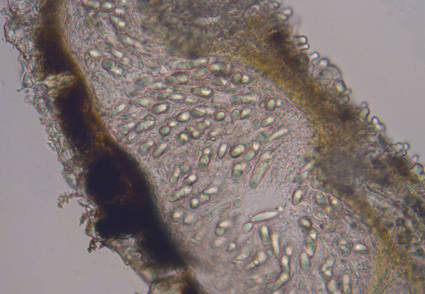Abstract
Thirty-seven Phyllachora specimens were collected in China and examined for morphological characteristics. A molecular phylogenetic analysis based on a combined sequence dataset of ITS and LSU was also undertaken. Phyllachora cephalostachyi sp. nov. on Cephalostachyum pergracile is described based on its distinct phylogenetic relationships and a comparison of its morphological characteristics with known Phyllachora species on bamboo. Our results indicate a high species diversity of Phyllachora on bamboo in China. A full description and colour photographs of micro-characters are provided for the new species. A phylogenetic tree to show placement of the new species, and a table to compare morphology of the Phyllachora species reported on bamboo are also provided.
References
Cannon, P.F. (1991) A revision of Phyllachora and some similar genera on the host family Leguminosae. Mycological Papers 163: 1–302. https://doi.org/10.1071/APP9930111
Dayarathne, M.C., Maharachchikumbura, S.S.N., Jones, E.B.G., Goonasekara, I.D., Bulgakov, T.S., Al-Sadi, A.M., Hyde, K.D., Lumyong, S. & McKenzie, E.H.C. (2017) Neophyllachora gen. nov. (Phyllachorales), three new species of Phyllachora from Poaceae and resurrection of Polystigmataceae (Xylariales). Mycosphere 8: 1598–1625. https://doi.org/10.5943/mycosphere/8/10/2
Doyle, J.J. & Doyle, J.L. (1987) A rapid DNA isolation procedure from small quantities of fresh leaf tissues. Phytochemical Bulletin 19: 11–15.
Hino, I. & Katumoto, K. (1955) Illustrationes fungorum bambusicolorum III. Bulletin of the Faculty of Agriculture, Yamaguti University 6: 29–69.
Katoh, K. & Standley, D.M. (2013) MAFFT multiple sequence alignment software version 7: improvements in performance and usability. Molecular Biology and Evolution 30: 772–780. https://doi.org/10.1093/molbev/mst010
Li, X.L., Yang, Z.X., Wang, X.X., Wang, Y. & Li, C.Y. (2018) Two new species of graminicolous Phyllachora. Mycosystema 37: 1127–1132. https://doi.org/10.13346/j.mycosystema.180054
Li, X.L., Wu, S.R., Wang, C.L., Feng, Y.L., Zhao, C.Y., Chen, Z.Q., Yu, J.F., Luo, R., Promputtha, I. & Sun, D.F. (2019) Two new species of Phyllachora (Phyllachoraceae, Phyllachorales) on bamboo from China. Phytotaxa 425: 78–86. https://doi.org/10.11646/phytotaxa.425.2.2
Orton, C.R. (1944) Graminicolous species of Phyllachora in North America. Mycologia 36: 18–53. https://doi.org/10.2307/3754878
Parbery, D.G. (1967) Studies on graminicolous species of Phyllachora Nke. in Fckl. V. A taxonomic monograph. Australian Journal of Botany 15: 271–375. https://doi.org/10.1071/BT9670271
Parbery, D.G. (1971) Studies on graminicolous species of Phyllachora Nke. in Fckl. VI. Additions and corrections to Part V. Australian Journal of Botany 19: 207–235. https://doi.org/10.1071/bt9710207
Parbery, D.G. & Langdon, R.F.N. (1964) Studies on graminicolous species of Phyllachora Fckl. IV. Evaluation of the criteria of species. Australian Journal of Botany 12: 265–281. https://doi.org/10.1071/BT9640265
Patouillard, N. (1914) Specific descriptor: megastroma. Bulletin de la Société Mycologique de France 30: 345–349.
Rambaut, A. (2012) Fig.Tree. Tree figure drawing tool. v. 1.4.0. Available from: http://tree.bio.ed.ac.uk/software/figtree/ (accessed 12 August 2021)
Rehm, H. (1914) Ascomycetes Philippineses–V. Leaflets of Philippine Botany 6: 2191–2195.
Rehner, S.A. & Samuels, G.J. (1994) Taxonomy and phylogeny of Gliocladium analysed from nuclear large subunit ribosomal DNA sequences. Mycological Research 98: 625–634. https://doi.org/10.1016/S0953-7562(09)80409-7
Saccardo, P.A. (1902) Sylloge Fungorum Omnium Hucusque Cognitorum, vol. 16. Patavii, Italy.
Saccardo, P.A. (1905) Sylloge Fungorum Omnium Hucusque Cognitorum, vol. 17. Patavii, Italy.
Saccardo, P.A. (1926) Sylloge Fungorum Omnium Hucusque Cognitorum, vol. 24. Patavii, Italy.
Sawada, K. (1943) Descriptive catalogue of Taiwan (Formosan) fungi VIII. Report Government Research Institute, Department of Agriculture Formosa 85: 1–131.
Stamatakis, A. (2014) RaxML version 8: a tool for phylogenetic analysis and post analysis of large phylogenies. Bioinformatics 30: 1312–1313. http://dx.doi.org/10.1093/bioinformatics/btu033
Swofford, D.L. (2003) PAUP*: phylogenetic analysis using parsimony (*and other methods). Version 4.0b10. Sinauer Associates, Sunderland. https://doi.org/10.1111/j.0014-3820.2002.tb00191.x
Tai, F.L. (1979) Sylloge Fungorum Sinicorum. Science Press, Beijing.
Tamakaew, N., Maharachchikumbura, S.S.N., Hyde, K.D. & Cheewangkoon, R. (2017) Tar spot fungi from Thailand. Mycosphere 8: 1054–1058. https://doi.org/10.5943/mycosphere/8/8/6
Theissen, F. & Sydow, H. (1915) Die Dothideales. Kritisch-systematische riginaluntersuchungen. Annales Mycologici 13: 147–746.
Thompson, J.D., Higgins, D.G. & Gibson, T.J. (1994) CLUSTAL W: improving the sensitivity of progressive multiple sequence alignment through sequence weighting, position-specific gap penalties and weight matrix choice. Nucleic Acids Research 22: 4673–4680.
Vilgalys, R. & Hester, M. (1990) Rapid genetic identification and mapping of enzymatically amplified ribosomal DNA from several Cryptococcus species. Journal of Bacteriology 172: 4238–4246. https://doi.org/10.1128/jb.172.8.4238-4246.1990
White, T.J., Bruns, T., Lee, S.J. & Taylor, J.L. (1990) Amplification and direct sequencing of fungal ribosomal RNA genes for phylogenetics. PCR protocols: a guide to methods and applications 18: 315–322. https://doi.org/10.1016/B978-0-12-372180-8.50042-1
Wu, J.W., Li, C.Y., Zhang, T., Zhang, L.Y. & Liu, L. (2013) Record of a new species of Phyllachora. Journal of Yunnan Agricultural University 4: 590–591.
Yang, C.L., Xu, X.L., Liu, Y.G., Hyde, K.D. & McKenzie, E.H.C. (2019) A new species of Phyllachora (Phyllachoraceae, Phyllachorales) on Phyllostachys heteroclada from Sichuan, China. Phytotaxa 392: 186–196. https://doi.org/10.11646/phytotaxa.392.3.2
Zhang, Z.Y. & Zhang, T. (2014) Flora Fungorum Sinicorum. Vol. 46: Phyllachora. Science Press, Beijing.


